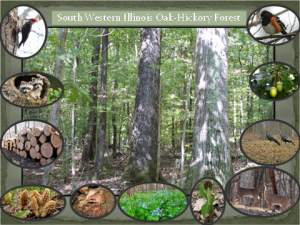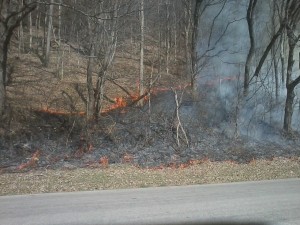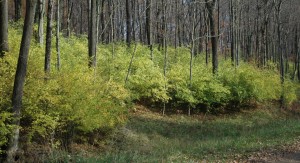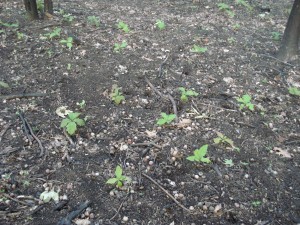The White Oak and the Oak-Hickory Forest of Monroe County
By Mark Brown, IDNR District Forester
Since the last glaciers receded over 10,000 years ago, the landscape of Illinois has been dominated by a patchwork of tall grass prairie and hardwood forest. Wildfire, touched off by lightning strikes and indigenous peoples, helped to form the landscape. Periodic fires would prevent woody plant species from encroaching upon prairies while also promoting forest species that were capable of thriving despite the flames. The forest ecosystem that developed over the millennia is known as the Oak-Hickory Forest, named for the most dominant trees such as white oak, northern red oak, bur oak, shagbark hickory, ash, black walnut and sugar maple. However, the Oak-Hickory Forest is far more than the trees it is named for, it’s actually a community of plants and animals, all largely dependent upon each other for survival.
And the tree that is probably depended upon the most is the white oak. It is arguably the cornerstone species of the Oak-Hickory Forest. It is a long-lived tree (often living to 200 years and perhaps as long as 400- 500 years) and often achieves heights of well over 100 feet with trunk diameters exceeding 3 feet. Whole communities of creatures live in its boughs and its seed, the acorn, provides sustenance for a long list of insects, birds and animals. A single white oak can produce several hundred pounds of acorns in a good year and the biggest trees can produce 1,000 pounds in a good year. A well-stocked Oak-Hickory Forest can produce 6,000 pounds of acorns per year. This tree is a veritable forest pantry and provides a last big meal for many species of wildlife that are facing a long winter or a long migration.
With so many hungry mouths to feed, it would seem that there might not be any acorns left to actually grow into white oak trees. Oaks, and white oaks in particular, have adapted to that pressure and only produce their biggest seed crops during “mast” years which occur every 5-10 years. Acorns will cover the autumn forest floor when a mast year is underway and few will be produced during intervening years. This serves a very specific and dual purpose: During mast years, oaks will produce more acorns than the waiting wildlife can consume and during the intervening years produce far fewer acorns and thus starve the acorn eating public, insuring there are fewer hungry mouths around when the big mast crop arrives, thereby increasing the odds of reproductive success (i.e. new trees). And this strategy wouldn’t be very successful to the white oaks if they weren’t all in on the plan…and oddly enough, they are! White oaks can synchronize their mast crops across huge areas (as much as 1500 miles!) so that they all produce mast crops in the same year and they all starve their acorn eaters in the intervening years as well. This intentional starvation might seem cruel but if not for this synchronization, the mast crop scheme simply wouldn’t work. A hungry squirrel would simply run to the next tree to find acorns if oaks didn’t synchronize their mast years. Somehow they are able to communicate this schedule to each other and while there is much speculation as to how they do it, no one really knows for sure.
We humans find the white oak an equally attractive tree but more for its wood than its acorn crop. White oak wood is hard and attractive. While it’s too hard (and expensive) for use in actually building houses, it is highly prized for a wide variety of uses in the home such as furniture, flooring, cabinets and paneling. It is the wood that repelled cannon balls from the white oak-sided USS Constitution, nicknamed Old Ironsides, during the revolutionary war. White oak is also the best wood for making whisky and wine barrels due to its cellular structure. For these reasons and more, white oak is probably the most valuable tree species in the state of Illinois, rarely falling out of demand with the timber industry.
But while the Oak-Hickory Forest has adapted well to the world as it has been for the last 10,000 years, it is having a great deal of difficulty adapting to the last 100 years or so. As people of European origins displaced the indigenous Native Americans, forests were cleared and fire was now viewed as a threat, not a tool. The Oak-Hickory Forest could recover from the initial over-cutting of our ancestors (oaks really can only reproduce successfully with heavy disturbance to the canopy to allow suitable light levels to reach the forest floor). They could not, however, cope with elimination of fire. Without the periodic fires to cleanse the forests, the shade loving trees like sugar maple, beech, hackberry, elm and others (known in conservation circles as “mesic” species) can move in and claim dominance. Mesic trees, almost as a rule, do not provide much sustenance to the local wildlife when compared to the oaks and their acorns and their wood isn’t usually as valuable to the timber industry. As the oaks die or are harvested, the mesics are poised for a takeover and are becoming the dominant timber trees in many forests throughout the Midwest. Mesic trees do not like fire so it would make no sense for them to produce leaves that fuel fires well. The fires that once sustained the Oak-Hickory Forest depended upon the thick, durable oak leaves to fuel the fires and without them, fire becomes less likely.
To make matters worse, shade tolerant invasive exotic plants like Asian bush honeysuckle have spread into the forests and have made the shade problem infinitely worse. Thick bands of green honeysuckle have filled up the understory in much of the forested acreage in Monroe and surrounding counties and can be seen clearly right now since they leaf out earlier than our native plants. Honeysuckle has been in Illinois since at least the 1850’s but has only really become a major forest problem in the last 2 decades. Its red berries are eaten by black bird flocks in the fall during their migration and the birds in turn have spread the seed far and wide. Bush honeysuckle also produces leaves that do not burn well and it tends to create a more humid environment at the forest floor that can make fire even less likely.
While the forecast for our native Oak-Hickory Forest and its cornerstone species, the white oak, indeed appears dire, it’s not gone yet. This problem can be corrected if we have the will. If you have land, educate yourself about how to bring this amazing forest and the bounty it provides back to prominence and most importantly, sustainability. The Illinois Department of Natural Resources has foresters, wildlife biologists, natural heritage biologists and Illinois Nature Preserve Commission biologists that may be able to provide assistance. If you have no land but would like to help, contact a conservation group such as Clifftop to volunteer your time. It won’t be easy and will undoubtedly take a lot of cutting, spraying and burning but too much is hanging in the balance to ignore and time is running out.
CLIFFTOP, a local nonprofit organization, is focused on preserving and protecting are blufflands.
A version of this article appeared in the May 4, 2018 edition of the Monroe County Independent.
© 2018 all content rights reserved Clifftop NFP
Comments are currently closed.




